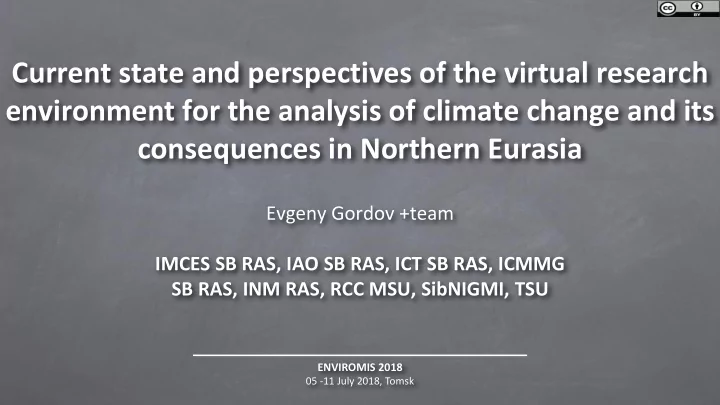

Current state and perspectives of the virtual research environment for the analysis of climate change and its consequences in Northern Eurasia Evgeny Gordov +team IMCES SB RAS, IAO SB RAS, ICT SB RAS, ICMMG SB RAS, INM RAS, RCC MSU, SibNIGMI, TSU ENVIROMIS 2018 05 -11 July 2018, Tomsk
Regional climate research challenges Multidisciplinary, often spatially distributed research activity Spatially distributed datasets of huge size Different formats of datasets obtained from different sources Specific knowledge is needed to search, extract and process data (problem for decision-makers) Risk of using unverified algorithms and data Necessity of climate servises to support adaptation/mitigation 2
Approach Internet accessible web-GIS with user-friendly GUI Web portal integrating web services providing search, retrieval, cartographical visualization, and client applications “Cloud” data analysis and visualization Flexible modular computational engine with verified data processing routines Combined usage of Web and GIS technologies Access to processing results: images (PNG, JPEG), binary files (NetCDF, float GeoTIFF, ESRI shapefile), web services (WMS ,WFS, WPS) DSS to support adaptation/mitigation 3
VRE architecture • Web-GIS client • Geoportal • Modular Computational Backend • Data archives + Metadata • Ontology/ Expert system • Intelligent DSS 4
Web portal (web server) Provides server-side: Authorization Database integration Localization Content management system Geodata manipulation and access (OGC Standards) PHP-controllers, JavaScript libraries, DHTML 5
Web-GIS client (user interface) Interactive map Menu bar, tool bar, status bar Layers list Legend window Context menu Libs: ExtJS, OpenLayers, GeoExt 6
Analysis capabilities (integrated data processing) Basic statistics: minimum/maximum, range, average values, standard deviation, variance, RMS… World Meteorological Organization climate change indices: number of frost days, growing season length, number of icing days, monthly maximum/minimum of daily maximum/minimum temperature, number of summer days, number of tropical nights.. Extreme value statistics. … more reliable mathematical and statistical routines New modules are easily developed and added on-demand! 7
Data archives (currently supported) Dataset Source organization Time coverage Spatial resolution 0.25 °× 0.25 ° , precipitations only APHRODITE Reanalysis RIHN-MRI/JMA 1951 - 2007 2.5 °× 2.5 ° , 23 vertical levels 1957 – 2004 ERA-40 Reanalysis ECMWF 1979 – 2012 0.75 °× 0.75 ° , surface ERA Interim Reanalysis ECMWF 0.5 °× 0.5 ° , precipitations only GPCC Reanalysis GPCC 1901 - 2009 2.5 °× 2.5 ° , 23 vertical levels 1979 – 2009 JRA-25 Reanalysis JMA/CRIEPI 1.25 °× 1.25 ° , 27 vertical levels 1958 – 2013 JRA-55 Reanalysis JMA/CRIEPI 0.67 °× 0.5 ° , 42 vertical levels MERRA Reanalysis ECMWF 1979 - 2014 1979 – 2003 2.5 °× 2.5 ° , 17 vertical levels NCEP/DOE AMIP II NCEP/DOE Reanalysis 1869 – 2011 2.0 °× 2.0 ° ; 24 vertical levels 20th Century Global NOAA/OAR/ESRL PSD Reanalysis Version II 0.5 °× 0.5 ° , 37 vertical levels NCEP Climate Forecast NCEP 1979-2010 System Reanalysis 2.5 °× 2.5 ° , 10 vertical levels PlaSim dataset IMCES SB RAS 2000 - 2100 1910 – 2011 Meteostations RIHMI-WDC 600 stations for Russia and CIS 8
Case study 1 (average air temperature calculation) 9
Case study 2 (external WMS layer) 10
11
12
13
14
15
Visualization examples Temperature at 2m, ERA Interim, average for 2000 16
Visualization examples Shaded - Precipitations, APHRODITE ’ s project, average for summer 1990 Contour – Temperature at 2m, ERA Interim, average for summer 1990 17
Visualization examples Surface temperature, meteostations, average for summer 1990 18
Full functionality of the web-GIS is provided by the portal for registered users only. Registration and authorization are under the heading labeled with a special icon. Educational resources, which do not require interactive computational support are open to any user. To access full functionality of the educational resources use the same login and password. Open part of the educational resources includes special module prepared for decision-makers, stake holders and general publics. Additionally to thematic lecture courses it comprises an interactive manual, glossary and a library of calculated files describing extreme climatic events occurring in Siberia. 19
20
21
User can look through a map of calculated characteristic for Siberia (Lat. 50-65, Lon.60-120) and download relevant files in a selected format (netCDF, GeoTIFF, WMS/WFS) and continue its processing/analysis using own desktop. Currently topics include: Min/Max temperatures; Days with frost; Hot/Cold nights/days; TN90n/TX90n; TN10n/TX10n; Extreme precipitations; return periods, etc. 22
Applied problems and IDSS 1. Evgeny P. Gordov, Igor G. Okladnikov, Alexander G. Titov, Alexander Z. Fazliev, Elements of the Virtual Research Environment for Big Environmental Data Analysis // CEUR Workshop Proceedings. 2017. – Vol. 2033. - P. 10-16. - ISSN 1613-0073. 2. Andrey Bart, Vladislava Churuksaeva, Alexander Fazliev, Evgeniy Gordov, Igor Okladnikov, Alexey Privezentsev, and Alexander Titov, Ontological Description of Applied Tasks and Related Meteorological and Climate Data Collections, DAMDID/RCDL 2017, CCIS 822, pp. 1 – 14, 2018. 3. Andrey Bart, Alexander Fazliev, Evgeny Gordov, Igor Okladnikov, Alexey Privezentsev, Alexander Titov, (2018). Virtual Research Environment for Regional Climatic Processes Analysis: Ontological Approach to Spatial Data Systematization. Data Science Journal. 17, 14.
Экспертная система и система поддержки принятия решений В виртуальной среде исследователя, содержащей коллекции данных и приложения, решающие типовые задачи, особую роль играют две компоненты: экспертная система и система поддержки принятия решений . Назначения экспертной системы в платформе «Климат+» состоит в решении задачи достижения семантической однородности климатических и метеорологических величин в разных коллекциях данных. Для решения этой задачи создается онтология таких величин, используемая экспертом при настройке приложений. В ВМО попытки создания суррогатов онтологий делались, но стандарта на онтологическое описание, характеризующее климатические и метеорологические величины до сих пор нет. Назначением системы поддержки принятия решений на платформе «Климат+» является создание условий для принятия решений в рамках логических теорий предметных областей с которыми эти решения связаны. Техническое решение создания базы знаний для принятия решений связано с технологиями Semantic Web , используемых для представления и обработки данных, информации и знаний информационных ресурсов в сети Интернет. Построение базы данных связано с решением двух задач: задачи сведения и задачи построения таксономии классов. На примере нескольких прикладных задач нами предложены решения задач сведения. Построение таксономий классов для онтологических баз знаний находится в разработке.
Recommend
More recommend